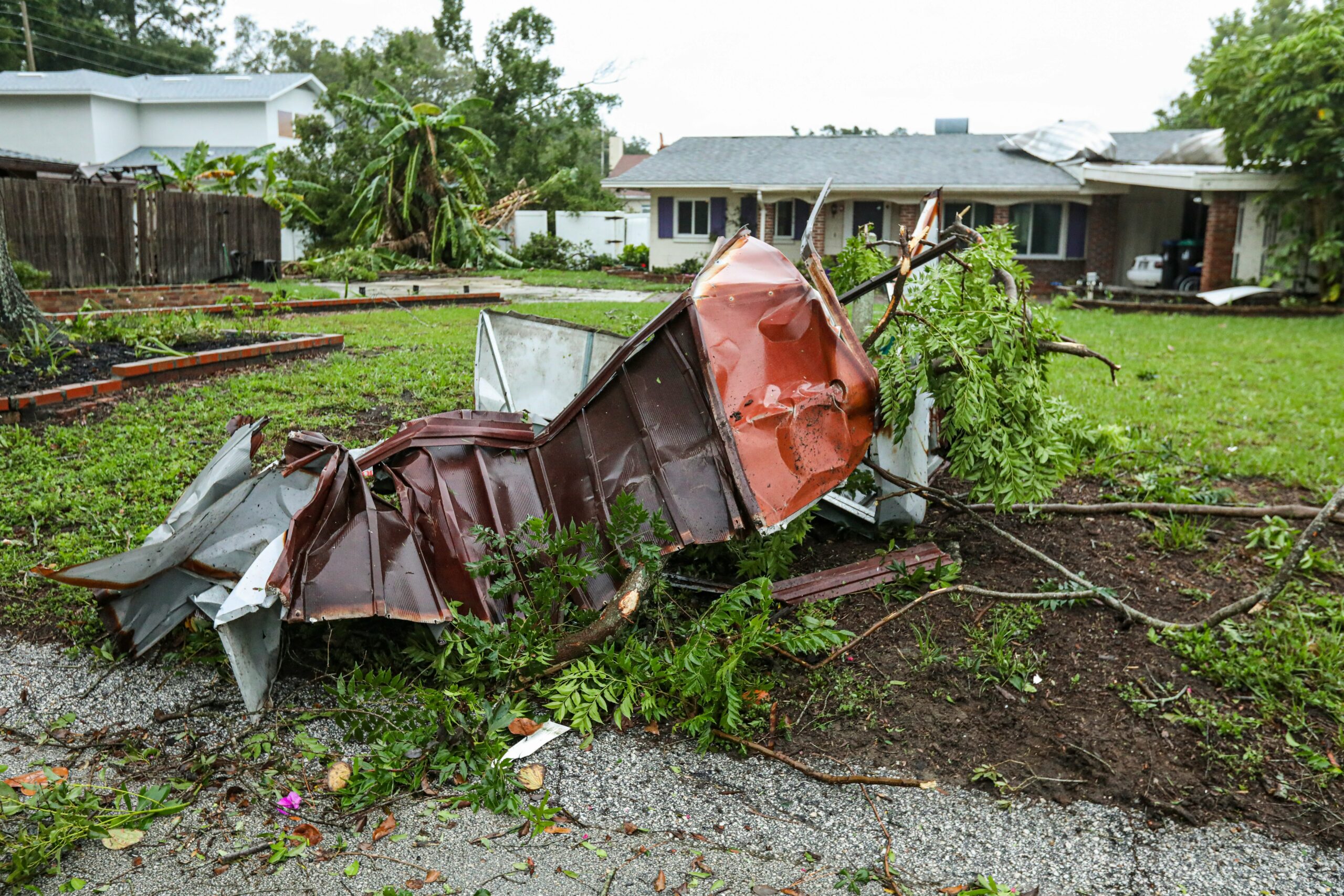Introduction to Storm Éowyn
Storm Éowyn, a significant weather event impacting the United Kingdom, emerged from a complex interaction of atmospheric conditions that facilitated its formation and intensity. Originating as a low-pressure system in the Atlantic Ocean, it gradually gained strength as it moved eastward towards the UK, driven by the jet stream’s dynamics. The meteorological factors contributing to this storm’s characteristics include varying temperatures, humidity levels, and wind patterns, which combined to create a potent weather phenomenon.
The arrival of Storm Éowyn brought with it a range of severe weather conditions, characterized by strong winds, heavy rainfall, and the potential for localized flooding. Such extreme weather events emphasize the importance of timely and accurate weather warnings. Understanding these alerts allows residents and authorities to take appropriate precautions, ensuring safety and minimizing disruption. For instance, effective communication of storm warnings enables communities to prepare for adverse conditions, such as securing property and avoiding travel during peak storm activity.
The significance of comprehending Storm Éowyn’s implications extends beyond immediate safety measures; it also contributes to long-term planning and resilience in the face of increasing weather extremities. As climate change influences weather patterns, events like Storm Éowyn may become more frequent and intense. This knowledge reinforces the need for effective public education regarding storm preparedness and response strategies. By staying informed through reliable weather updates, individuals can better navigate the challenges posed by such storms, ultimately fostering a deeper understanding of the impacts associated with severe weather events.
Met Office Weather Warnings Explained
The Met Office plays a crucial role in maintaining public safety through the issuing of weather warnings. These warnings are vital for informing the public about potentially hazardous weather conditions that could impact daily life and safety. The Met Office categorizes these alerts into three main levels: yellow, amber, and red, each indicating the severity of the expected weather conditions.
A yellow weather warning serves as an initial alert, indicating that while the weather may cause some disruption, it is not expected to pose a significant risk to life or property. This warning encourages individuals and communities to remain vigilant, particularly when planning travel or outdoor activities. It helps raise awareness of potential impacts, such as disrupted travel schedules or local flooding.
The second level, an amber warning, suggests a higher likelihood of severe weather effects. This warning indicates that significant disruptions are possible, and individuals should be prepared for adverse outcomes. For instance, heavy rainfall or strong winds associated with Storm Éowyn could lead to road closures, power outages, or increased emergency services activity. The public is advised to take precautions, such as avoiding non-essential travel during periods of heightened risk.
Lastly, the red warning signifies extreme weather, where conditions pose a serious risk to life and property. At this stage, it is imperative that the public take immediate actions to protect themselves and their property. Red warnings may result from severe storms, heavy snowfall, or high winds, and individuals should follow official guidance diligently. Understanding these warning levels allows the public to interpret alerts effectively and respond appropriately, mitigating the potential impacts of severe weather events like Storm Éowyn.
Impact of Storm Éowyn on Different Regions
Storm Éowyn has been a significant weather event in the UK, bringing diverse effects across various regions, each experiencing unique challenges associated with high winds, heavy rain, and localized flooding. In Edinburgh, the storm has caused considerable disruption, with wind speeds reaching up to 70 mph. These high winds have resulted in downed trees, damaged infrastructure, and power outages in multiple areas, prompting local authorities to issue weather warnings to ensure public safety. The heavy rainfall accompanying the storm has added to the challenges, with some regions recording over 50mm of rain within a short timeframe, raising concerns about flash flooding.
Similarly, London has faced its own set of difficulties due to Storm Éowyn. The capital has experienced gusty winds, albeit not as intense as those in Scotland, which has led to minor damages and transportation delays. High winds have caused disruptions in public transport services, including bus and train delays, affecting the daily commute for many residents. Additionally, London’s drainage systems have been put to the test as rain falls heavily. While flooding has not been as severe as in some other urban areas, alerts have been issued for certain boroughs where surface water accumulation could lead to localized flooding. The combined effects of the storm can extend into social, economic, and environmental dimensions, impacting local businesses and disrupting everyday life.
In the context of these varying conditions, it is crucial for residents in affected areas to stay informed and heed safety warnings issued by relevant authorities. Storm Éowyn serves as a reminder of the potential impacts of severe weather and the need for preparedness, particularly in regions prone to such events.
Safety Measures and Preparedness
As Storm Éowyn approaches the UK, it is imperative for individuals and communities to adopt appropriate safety measures to mitigate its potential impacts. Preparation can significantly reduce risks to life and property, thus ensuring that households are equipped to face the challenges posed by severe weather events.
Firstly, homeowners should focus on securing their properties. This includes checking and reinforcing roof tiles, securing loose items in the garden, and ensuring that gutters are clear to facilitate proper drainage. Additionally, it is essential to close windows and doors to prevent water ingress and reduce the risk of structural damage. Community organizations should also collaborate to assist vulnerable residents by providing resources and support for fortifying their homes.
Creating an emergency kit is another prudent step for preparedness. An emergency kit should consist of essential items including, but not limited to, bottled water, non-perishable food, flashlights, batteries, first-aid supplies, and necessary medications. It is advisable to include a battery-powered radio to receive weather updates, as well as contacting information for local emergency services. This kit should be easily accessible to all household members.
Travel can become hazardous during Storm Éowyn due to flooding, fallen trees, and other weather-related incidents. It is advisable to avoid unnecessary travel when alerts are issued. For those who must venture out, checking the latest travel updates and road conditions through local news or traffic websites is crucial. Personal safety should always take precedence, and individuals should remain vigilant regarding rapidly changing weather conditions.
Finally, staying connected to real-time weather information is vital. Utilizing weather apps, subscribing to weather alerts from authoritative sources, and following local news channels can keep individuals informed about the storm’s progression and associated alerts. By taking these preemptive actions, communities can enhance their resilience against the impending challenges presented by Storm Éowyn.
Personal Accounts: Experiences During the Storm
The impact of Storm Éowyn on individuals across the UK is illustrated through various personal accounts that highlight both the challenges faced and the resilience displayed by communities. For many, the storm represented a stark reminder of nature’s power. A resident of South Wales described the frightening intensity of the winds, recalling how the sound was reminiscent of a freight train passing nearby. As the storm surged, she and her family huddled indoors, monitoring the news for updates, their anxiety palpable as they witnessed trees swaying perilously outside their windows.
In contrast, an individual from East Sussex shared a different experience. He recounted his astonishment when he saw a neighbor actively attempting to clear debris from the street, showcasing a spirit of community solidarity. Despite the hazardous conditions, many residents offered assistance, helping those who were vulnerable or unable to cope with the extreme weather. The storm catalyzed acts of kindness, where people united to check on elderly neighbors or share resources, illustrating how adversity can foster a sense of camaraderie.
Moreover, the disrupted transportation links also underlined the storm’s consequences. A student from London described how her daily commute was transformed into a significant challenge, causing delays and cancellations that impacted her education and work. This interruption underscored the broader implications of Storm Éowyn’s ferocity; it affected not only individual lives but also the economy and education systems across the region.
These personal stories encapsulate the profound effects of Storm Éowyn, painting a vivid picture of the trials and triumphs experienced during this tumultuous weather event. Each account serves as a testament to human resilience and the unyielding spirit of community in the face of severe challenges posed by nature.
Comparative Analysis of Previous Storms
Storm Éowyn, which has recently impacted the United Kingdom, can be compared to several significant storms from the past, enhancing our understanding of its characteristics and the response mechanisms employed. Notable storms such as Storm Ciara, which occurred in February 2020, showcased immense rainfall and caused widespread flooding across many regions. Similarly, both Storm Éowyn and Ciara exhibited a pattern of intense low-pressure systems that significantly influenced wind speeds and precipitation levels. In the same vein, the destructive force of Storm Dennis, also in February 2020, is a pertinent comparison, as it brought about severe weather conditions similar to those experienced during Storm Éowyn.
When considering the severity of these weather events, Storm Éowyn appears to align closely with Storm Arwen, which occurred in late 2021. Storm Arwen was marked by strong winds, resulting in extensive damage and power outages. Likewise, Éowyn’s high wind speeds prompted warnings from the Met Office, suggesting that its impact could be equally severe. In both cases, the combination of heavy winds and falling trees posed significant risks to public safety and infrastructure.
The response measures employed during these storms reveal lessons learned and improvements made over time. For instance, the experience gained from previous storms has led to enhanced predictive capabilities, allowing for timely weather warnings during Storm Éowyn. This advance notice, paired with public awareness campaigns, has highlighted the importance of preparation before extreme weather strikes. As the UK continues to face challenges from climate change, the reflections drawn from past storms will be critical in shaping future responses to events similar to Storm Éowyn, thereby ensuring communities are better equipped to handle the impacts of severe weather.
Economic and Environmental Impacts
Storm Éowyn is projected to inflict significant economic and environmental repercussions across the UK. The extreme weather conditions associated with this storm pose a risk to vital infrastructure, including transportation networks, power lines, and communication systems. Damage to roads and railways can hinder connectivity, disrupting not only daily commutes but also the broader supply chains that drive economic activity. This disruption can lead to increased costs for businesses, potentially resulting in job losses and a decrease in consumer spending. The financial implications might extend to the insurance sector as claims could see a substantial rise following the storm damage.
Furthermore, the agricultural sector is particularly vulnerable during such storms. High winds and heavy rainfall can lead to soil erosion, crop damage, and livestock distress. These factors will negatively impact food production and could cause food prices to rise, affecting households across the UK. In the long term, communities reliant on tourism may also experience adverse effects, as storm-related damage can deter visitors and lead to a decline in local economies. In addition to these economic concerns, the environmental impacts of Storm Éowyn are profound.
Heavy rainfall and flooding can devastate local ecosystems, affecting both flora and fauna. Aquatic habitats may suffer due to runoff carrying pollutants from urban areas, leading to water quality degradation. Moreover, the physical damage caused by high winds can displace wildlife and disrupt natural habitats. Storms can also exacerbate climate-related challenges, emphasizing the necessity for enhanced weather preparedness and sustainable practices. Effective planning and immediate response strategies will be crucial for mitigating the adverse effects of Storm Éowyn on both the economy and our environment.
Long-term Weather Patterns and Climate Considerations
The understanding of storm occurrences, including Storm Éowyn, hinges significantly on long-term weather patterns and climate considerations. A comprehensive analysis reveals that our climate has been altering considerably over recent decades, impacting not only the frequency but also the intensity of storms in the UK. The increasing prevalence of extreme weather events can largely be attributed to climate change, which has been linked to rising global temperatures.
Research indicates that warmer atmospheric conditions can enhance the ability of storms to gain strength, leading to more intense weather patterns. This is a critical factor contributing to storms similar to Éowyn, as warmer seas can increase evaporation and provide additional energy for storms. Increased sea surface temperatures have been observed in the North Atlantic, creating conditions that are conducive to increased storm activity. Thus, the interrelation between a warming climate and potential storm outcomes is worth highlighting.
Moreover, long-term climate assessments show evidence of shifts in jet streams and pressure systems. Changes in these fundamental weather patterns can lead to prolonged wet periods, heightened winds, and increased likelihood of severe storms hitting the UK. These alterations often result in unpredictable weather, complicating both emergency planning and response efforts. As we consider the implications of future storms, it becomes imperative to recognize the overarching trends in our climate that contribute to such severe weather phenomena.
In summary, the interplay between climate change and storm activity is a pressing concern that requires further exploration and understanding. As these long-term weather patterns continue to evolve, preparation and adaptation strategies will be essential in mitigating the impacts of storms like Éowyn on communities across the UK.
Conclusion and Final Thoughts
In examining Storm Éowyn, we have highlighted the critical aspects of weather warnings and the resultant impacts across the UK. Understanding the nuances of severe weather events is paramount for ensuring both individual and community safety. Over the course of this discussion, we explored the meteorological factors contributing to the formation of Storm Éowyn and identified the specific areas most affected by its forces.
The issuance of weather warnings serves as a vital resource, alerting the public to potential dangers associated with severe weather conditions. These alerts are not merely suggestions but are founded on extensive research and forecasting models. It is essential for residents to take these advisories seriously, heeding the guidance provided by authorities to mitigate risks. Our review of the impacts, including disruptions to transport and the potential for property damage, underlines the need for preparedness.
Moreover, a collective approach toward safety during such weather events is necessary. Community engagement, sharing information, and assisting one another can significantly enhance resilience against the adverse effects of storms. Individuals are encouraged to develop personal safety plans and stay updated on forecasts, reinforcing the notion that awareness and action are critical components of weather preparedness.
As we have seen, Storm Éowyn demonstrates that the power of nature can disrupt daily life in unforeseen ways. By being proactive in response to severe weather warnings, we not only safeguard our own well-being but also contribute to the safety of our communities. In summary, staying informed and respecting the authority of weather warnings is a shared obligation that empowers us all to navigate the challenges posed by storms effectively.



